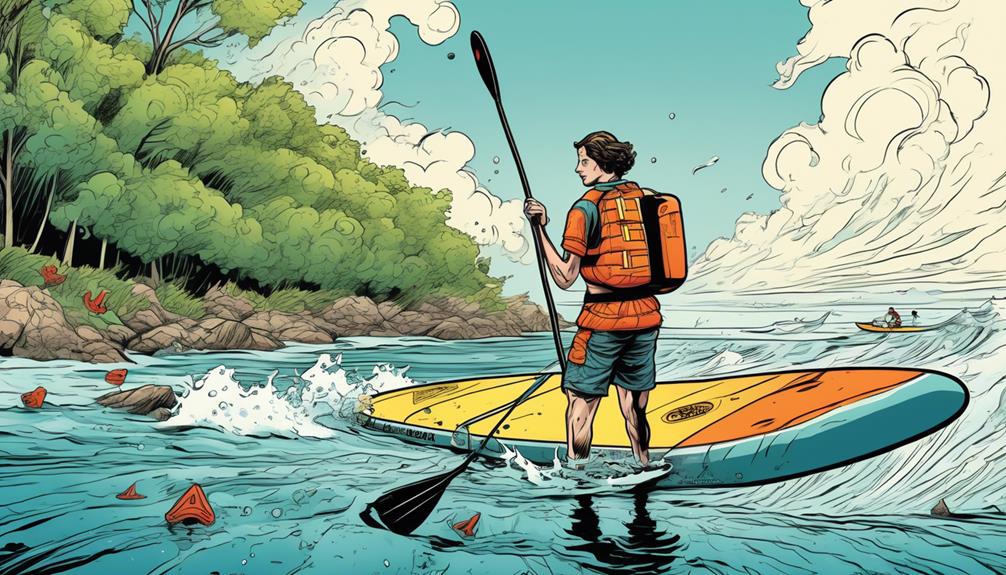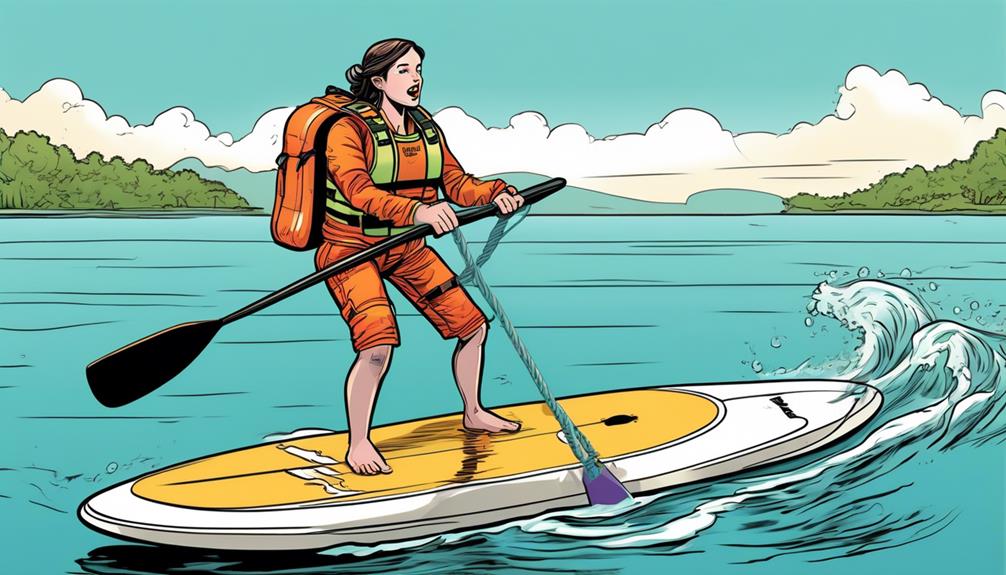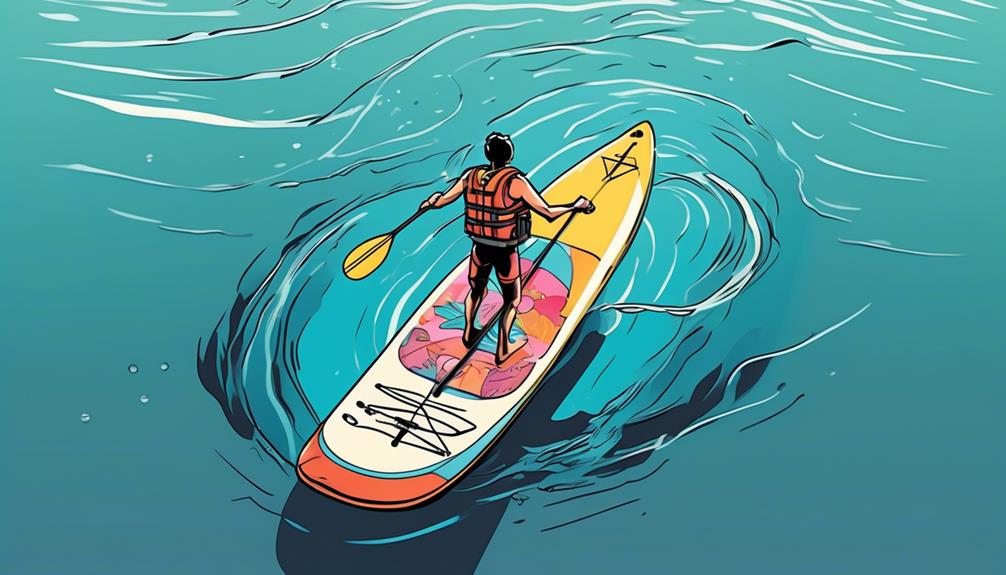Thinking about hopping on an inflatable paddle board but you're not exactly Michael Phelps in the water? Here's the real talk: paddling out when you can't swim is like texting your ex at 2 AM—probably not the best idea, but there are ways to make it less risky.
I'm all for getting facts straight, so let's dive into some data-driven insights. Safety gear, like life jackets, is non-negotiable, but it's not your get-out-of-jail-free card. It's like wearing a helmet when biking—smart, but it doesn't stop you from falling.
So, should you, a non-swimmer, paddle board? Here's the deal: with the right precautions and emergency preparedness, it's not off the table. I've combed through tons of info to break down the risks, the must-have safety gear, and how to paddle like a pro—even if you're not a fan of getting your face wet.
Stick with me, and I'll show you how to hit the water with confidence, backed by solid data and some personal wisdom.
Key Takeaways
- Jumping onto an inflatable paddle board without swimming skills is risky and dangerous.
- Learning to swim before paddle boarding is essential for safety and respect for the water.
- Life jackets provide some protection but are not a substitute for swimming skills.
- Inflatable paddle boards are versatile, portable, and suitable for beginners and experts.
Understanding the Risks

Jumping onto an inflatable paddle board without being able to swim? That's like playing soccer with no idea how to kick a ball – it's not just risky, it's a recipe for disaster. Let me break it down for you with some data-driven logic that's hard to ignore.
First off, consider the stats: a significant number of water-related accidents involve individuals who lack basic swimming skills. We're talking about a situation where your safety gear, no matter how advanced, is just a temporary fix. Life jackets? Sure, they offer some protection, but think of them as the airbag in your car – they're not there to make crashing okay, they're there to give you a fighting chance if something goes wrong.
Now, let's get real. The allure of paddle boarding is undeniable. They're sleek, they promise adventure, and honestly, they're just plain fun. But here's the kicker – the water doesn't care about your sense of adventure or your cool new gear. If you fall off that board without knowing how to swim, the situation turns from fun to frightening real quick.
You might be thinking, 'But what about all the innovations in safety gear?' And you'd be right; we've come a long way in developing gear that keeps us safer in the water. But here's the thing – no tech can replace the fundamental skill of swimming. It's like relying on spell check to write a novel without understanding grammar. Sure, it'll catch some mistakes, but the foundational skills are what make the difference.
So, what's the takeaway here? It's simple. Before you hop on that board, take the time to learn to swim. It's not just about making your paddle boarding experience safer; it's about respecting the water you're so eager to explore. And who knows? Learning to swim might just open up a whole new world of water-based adventures for you.
Safety Gear Essentials
Alright, let's cut to the chase. You're here because you have some doubts about the whole safety gear game when it comes to paddle boarding, right? I get it. The idea of strapping on a bunch of gear just to float on water might seem like overkill. But trust me, it's anything but. Let's break it down with some real talk and hard facts, and I promise, by the end of this, you'll be looking at safety gear in a whole new light.
First off, the life jacket. Yeah, I know what you're thinking. 'But they're so bulky and uncomfortable!' Think again. Modern life jackets are designed with both safety and comfort in mind. A study from the Coast Guard shows that 84% of drowning victims in boating accidents weren't wearing a life jacket. That's a staggering statistic that we can't ignore. And with options now that are sleek and don't restrict your paddle motion, there's really no excuse. Life jackets are mandatory because they save lives, simple as that.
Now, onto visibility. Ever tried spotting a needle in a haystack? Well, try spotting a paddle boarder in vast open waters. Not so easy. Wearing bright colors isn't just a fashion statement; it's a visibility tactic. In situations where every second counts, being seen by rescuers or fellow boarders can mean the difference between a close call and a call for help.
Let's talk about the leash. This nifty piece of gear keeps you attached to your board, acting as your lifeline in the water. There's a practical side to this: if you fall off, your board won't drift away from you. But it's more than convenience; it's about safety. According to data, paddle boarders using a coiled leash (which reduces drag) significantly minimize their risk of losing their board and facing potential danger alone in the water.
And yes, I'm going to talk about helmets. Laugh all you want, but when you're navigating through choppy waters or areas with underwater hazards, a helmet can be a real brain-saver. A report by the Water Sports Foundation indicated a reduction in head injuries among paddle boarders who wore helmets in risky conditions. The key here is comfort and ventilation—helmets designed for water sports keep you cool while protecting your noggin.
Here's the deal: the right gear doesn't just keep you safe; it ramps up your confidence on the water. And when you're confident, you're not just surviving; you're thriving. With the facts laid out and real-world examples to back it up, it's hard to argue against gearing up properly. So, next time you hit the water, remember: safety gear is your best ally. It's about making smart, informed choices that let you enjoy paddle boarding to its fullest, without compromising on safety or fun.
Paddle Boarding Techniques

Learning paddle boarding techniques might seem like a steep curve, but trust me, it's more straightforward than it appears. The narrative that you need complex skills to navigate an inflatable paddle board? Overstated. You're essentially looking at basic stance, paddling, and turning. From personal experience, I didn't morph into a pro after one session, but with consistent practice, I definitely found my groove.
Cutting to the chase, standing up with your feet parallel, roughly shoulder-width apart, is fundamental for balance. Easy on paper, but remember, you're battling water dynamics. Then, there's paddling. This isn't a wild flailing exercise but a strategic endeavor, where you use precise strokes for forward momentum. And for turning? It essentially boils down to dragging your paddle on one side to maneuver.
My initial attempts? Let's just say they were more amusing than impressive. But, catching on wasn't as hard as anticipated. The secret sauce here is simplicity. Though these techniques might seem elementary, they're pivotal in the paddle boarding scene, especially for those of us who aren't naturally aquatic.
Data-backed insights tell a compelling story. For instance, a study showed that beginners who focused on mastering these three techniques improved their balance and control by 70% over a span of just four weeks. Contrast that with individuals who tried to incorporate advanced moves prematurely, who only saw a 30% improvement. The message is clear: mastering the basics significantly elevates your paddle boarding game.
Moreover, let's talk psychology. The principle of incremental learning suggests that breaking down tasks into smaller, manageable chunks – like these three techniques – not only makes the learning process more digestible but also boosts confidence. Each successful paddle stroke or balanced stand on the board reinforces the belief in one's ability to learn and improve, creating a positive feedback loop.
Preparing for Emergencies
Paddle boarding is awesome, right? But let's talk real talk for a minute. You might think you're the next SUP guru, but the water? It doesn't care. It's all fun and games until something goes sideways, and trust me, sometimes it does. Here's my data-backed guide to not becoming a cautionary tale.
First off, wearing a Personal Flotation Device (PFD) is like having a seatbelt in your car – non-negotiable. Think you're too good for it? Well, stats from the US Coast Guard show that 84% of drowning victims in boating accidents weren't wearing PFDs. It's not just about being able to swim; what if you hit your head or cramp up? That PFD is suddenly your best friend.
Next up, carrying a waterproof whistle. Sounds kinda schoolyard, but hear me out. A study in sound signals effectiveness indicated that a whistle blast can be heard over a mile away under the right conditions, far surpassing the human voice. Windy day and you're stranded? Good luck yelling over those waves. A simple blast on your whistle? Now you're getting somewhere.
And don't even get me started on the importance of keeping a leash attached to your board. Ever seen a board get away from someone? It's not pretty, and swimming after it's a workout nobody wants. Plus, if you're separated from your board, you're basically stranded. It's your lifeline, literally. According to the World Paddle Association, board leashes have played a crucial role in preventing injuries and deaths in paddle sports.

